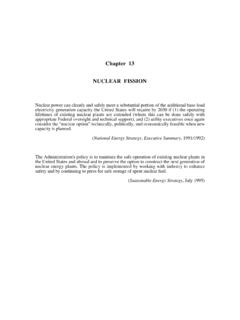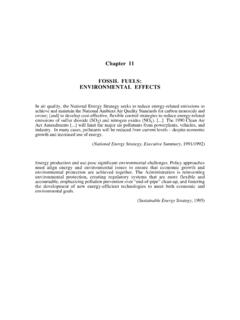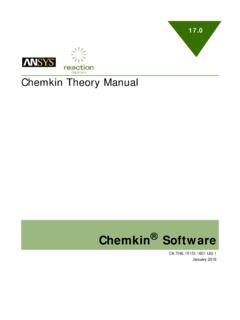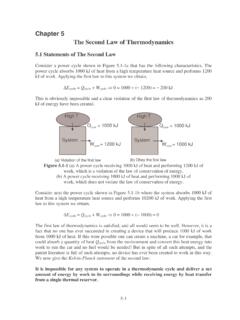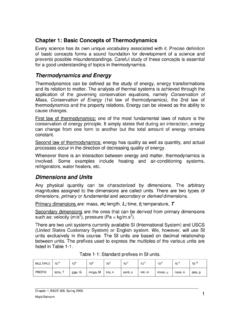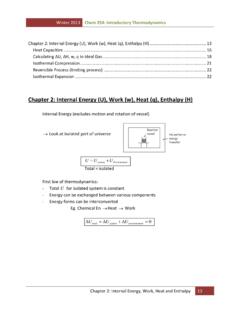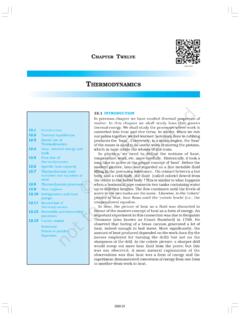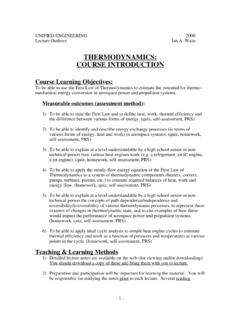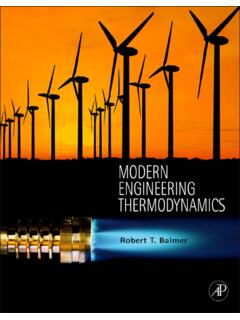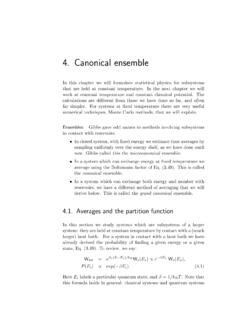Transcription of Chapter 2 CONCEPT OF ENERGY
1 Chapter 2 CONCEPT OF ENERGYC entre Daily Times8/11/96 Copyright: Mort Walker. Reproduced with permission of the 2 Beetle Bailey is not the only one who wants to save ENERGY . ENERGY conservation andefficiency is on many people's minds lately, especially when ENERGY becomes ENERGY conservation and modern ENERGY -guzzling society compatible? To begin toanswer this question, we must first define ENERGY ( Chapter 2 and 3) and then see what wemean by ENERGY efficiency ( Chapter 3 and 4).Qualitative Definition of EnergyMost dictionaries define ENERGY as the capacity to do work. This implies that ENERGY is amore abstract CONCEPT than work. The definition is correct, of course, but it is is certainly an important manifestation of ENERGY ; indeed, the Industrial Revolutionwent into full swing in late eighteenth century when breakthroughs were achieved inconverting other forms of ENERGY into work.
2 But work is not the only palpable form ofenergy. Heat is another important ENERGY form; a lot of effort and expense is made bysociety to remove heat from our homes and offices in the summer and to bring it to them inthe winter. And radiation too, for better or for worse, is ENERGY that we can sense. Hence,a more complete definition is the following: ENERGY is a property of matter that can be converted into work, heat or speaking, both work and heat are processes by which ENERGY can be changed butwe don't need to worry about this subtlety here. A good analogy is that ENERGY is likemoney in the bank, while heat, work and radiation are like cash, checks and money dictionaries cite the year 1599 as the date of the earliest recorded use of the term ENERGY in English.
3 This may be so, but it took another two and a half centuries for itsmeaning to be understood completely. Indeed, its precise definition, together with that ofentropy (see Chapter 3), is one of the greatest intellectual achievements of instructive analogy can be drawn between the rather abstract CONCEPT of ENERGY andanother more or less abstract but familiar property of (living) matter: our health. Health is aGod-given property that we have, to which we often pay little attention, until we lose , ENERGY is a property that humans and others both living and nonliving matter possess to a greater or lesser extent; we are pretty much unaware of its existence, however,until it is converted into work, heat or above definition of ENERGY highlights the fact that ENERGY conversion is essential forenergy utilization.
4 We shall discuss this in detail. We shall see that the quantity of energyavailable in the universe is constant. It cannot be created or destroyed; it is onlytransformed from one form to another. In other words, it is conserved in all thesetransformations. Work and heat (as well as some types of radiation) are forms of energythat society needs. These are also the ENERGY forms used today for the production of electricenergy (or electricity). Unfortunately, however, these are not the primitive forms ofCONCEPT OF ENERGY9energy. They are not the ENERGY forms that are readily available on our planet. The primitiveand less palpable forms of ENERGY such as solar, gravitational, chemical and nuclearenergy need to be converted to work, heat and useful radiation.
5 The entire problem ofenergy availability can be reduced to that of conversion of abundant but less convenientforms of ENERGY into scarce and more convenient forms which our society needs most. Afew examples are outlined below. We shall examine them in more detail in Chapter : Evolution of a conceptHistorians of science have probably written more essays on the development of the conceptof ENERGY than on any other subject. This CONCEPT has evolved from those of the archaicfire, the more modern vis viva ( living force ), which was dominant until the nineteenthcentury, and force, which persisted well into the 19th century and today has a muchnarrower scope. It was Aristotle (384-322 BC) who developed the CONCEPT of fire as oneof four basic elements of nature first described by Empedocles (490-430 BC), the otherthree being earth, water and air.
6 This view remained unchallenged for the next twothousand years. The largely apathetic and deeply religious scientists of the Dark andMiddle Ages did not seem to care to clarify it. The age of Enlightenment had to comeeventually, and it did in the late seventeenth century. The inquiry into the how's and thewhy's of this world was then not only resurrected but it was systematized into what wetoday know as the scientific method. This allowed Leibniz (1646-1716) to champion theidea that the vis viva of a body is its mass times the square of its speed (what we nowknow to be twice the kinetic ENERGY of a body). In the ensuing 150 years or so, the rapidlygrowing scientific community was successful in drawing a clear distinction between themore abstract concepts of force and ENERGY and the less abstract concepts of heat and invention of the thermometer as early as in 1592 by Galileo Galilei (1564-1642) andthen by Fahrenheit (1686-1736) in the early eighteenth century first helped to clarify thedistinction between temperature and heat.
7 The detailed studies of heat by Joseph Black(1728-1799) then inspired James Watt (1736-1819) to develop the first modern steamengine which propelled the Industrial Revolution throughout the nineteenth century andbeyond. This crucial technological development in turn inspired the scientific community tounravel the laws that govern the conversion of heat to work (see Chapter 3).In contrast to the early human realization that mass is conserved in all earthly andheavenly phenomena (for an important exception, see Chapter 12), the fact thatconservation of ENERGY is an even more basic law of the universe did not become clear untilmid-nineteenth century, when the science of thermodynamics was developed.
8 The keyplayers in this fascinating story of simultaneous discoveries are the Englishmen ThomasYoung (1773-1829) and James Joule (1818-1889), the American-born BenjaminThompson (1753-1814), the Germans Robert Mayer (1814-1878) and Hermann Helmholtz(1821-1894), the Frenchman S guin (1786-1875) and the Dane Ludvig Colding (1815-10 Chapter 21888). While Young is better known for having demonstrated the wave-like character oflight and for his research on the elasticity of materials, he is often credited for being thefirst, in 1807, to use the word ENERGY in its modern scientific sense. Thompson, betterknown as Count Rumford a remarkable personality, very popular among historians forhis military and political adventures which earned him nobility in both England and Bavaria clarified the nature of heat by showing in 1804 that it is not a fluid-like substance, aswidely believed until then.
9 This realization and the analysis of interconversion between heatand work by S guin, Mayer, Colding and especially Joule, in the period 1839-1849,clarified the relationship between heat and work, as two qualitatively different butquantitatively equivalent forms of ENERGY . Finally, in 1847 the inspired young Helmholtzgeneralized this principle of conservation of ENERGY into a universal law of nature, whichcame to be known as the First Law of is some irony in these historical developments: just before major social upheavalswere to spread throughout most of Europe in the revolutions of 1848, the collective effortsof the European scientific community brought about one of the major intellectual synthesesof all in Its Various Forms: First approximationWork.
10 When we lift an object (this book, for example) from one level to another (say,from the floor to a shelf on the wall), we expend our ENERGY by doing work to increasethe ENERGY stored in the object. (This ENERGY can be converted back into work, for example,if we let the book fall back to the floor.) In this transformation, the chemical ENERGY storedin our muscles is converted to work, or more precisely to mechanical ENERGY , and work isconverted into the potential ENERGY stored in the object (while it sits on the shelf).Heat. When we put a kettle filled with water on an electric stove, the temperature of thewater increases, typically from 60 to 200 degrees Fahrenheit. The ENERGY of the water(sometimes called thermal ENERGY ) increases, and we can dissolve coffee and sugar in it.




